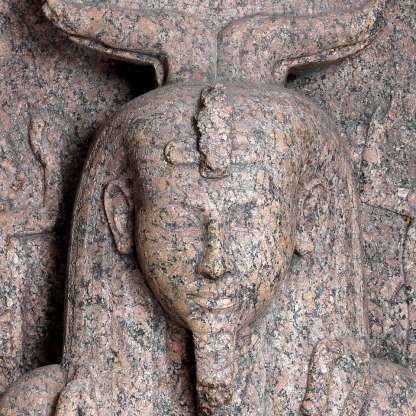Minoan Head

Barbara Hepworth’s account of her own life, published in 1970, was subtitled A Pictorial Autobiography. At 127 pages, it is a short book, considering that it covers sixty-seven years, yet it is crammed with pictures. Words alone were not adequate to describe the artist’s memories and feelings about her influences, her relationships and her work. As with her life, so with her sculpture.
Ultimately this piece of carved marble, like so much else that Hepworth produced, is not an image of anything other than itself. It is a unique entity, a presence that absorbs and reflects whatever associations the viewer brings to or takes from it. As Hepworth herself said in her autobiography, 'It is difficult to describe in words the meaning of forms because it is precisely the emotion which is conveyed by sculpture alone ...'
And yet she has provided words to accompany this object, surprisingly precise words, and it is worth considering what light the title sheds upon the sculpture. Minoan Head is a late work, but stylistically it has much in common with the sculpture Hepworth produced in the 1930s, when she was moving away from representations of the human body towards more purely abstract forms.
Viewed from the angle in the main photograph, the sculpture could indeed be interpreted as a very stylised human head, the hole bored through it a wide, all-seeing eye. Seen from the other side, in profile as it were, the similarity is perhaps more pronounced: the eye is sunk within a large socket, and the curve on the upper right recalls a forehead. But as soon as the viewer moves, this impression changes. Our response to the work depends upon the angle from which we view it.
What of the adjective Hepworth uses to describe the head? The culture that flourished around the Aegean island of Crete, between roughly 3000 and 1050 BCE, was first called Minoan, after the legendary King Minos, at the end of the nineteenth century by the archaeologist Sir Arthur Evans. But the small amount of sculpture from the period that survives does not resemble Hepworth's marble in any significant way.
The artist uses the word associatively, rather than specifically. Hepworth’s friend and fellow sculptor Henry Moore, in describing Cycladic art, which is closely related to Minoan, praised the 'great elemental simplicity' of the marble statuettes. Hepworth is perhaps hinting at something similar here: her white, carved marble has a presence, a dignity, an intrinsic beauty, an ancient Greek-ness, that she personally associated with the word 'Minoan'.
The sculpture of Greece was an important influence on Hepworth throughout her life. When she finally visited the country in the 1950s, her response bordered on the ecstatic. The Pictorial Autobiography records her impressions of the columns on the Athenian Acropolis:
'... the breadth, weight and volume – the magnificence of a single marble ... the passionate warm colour... and the all-pervading philosophic proportion and space'
The same words could serve as a caption to Minoan Head.
The white marble of the sculpture with its immaculately smooth finish is strikingly beautiful, and it seems to crave sunlight. Just as many of Hepworth’s other works reflect the rugged, hilly landscape of her native Yorkshire or the coastline of Cornwall, where she spent most of her life, perhaps Minoan Head is a composite of her memories of Greece: its light, its architecture and art, its religion and mythology.
The title suggests a way of seeing, provides one of a potentially limitless number of interpretations. As Paul Nash, himself an abstract artist, wrote when reviewing an exhibition of Hepworth’s sculpture in 1932:
'Each object is purely sculptural – the embodiment of an idea neither literary, naturalistic, nor philosophical but simply formal: its meaning is itself, itself the only meaning.'
Themes and periods
Data from our collections database
Minoan Head. White marble, carved with two grooves running from top to bottom, and one shorter groove on one side, pierced by a circular slanting hole; on wooden base.
Trustees of the Estate of Barbara Hepworth; lent to the Fitzwilliam Museum in 1978; allocated to the Museum following acceptance in lieu by the Department for Culture, Media and Sport, from the Estate of Barbara Hepworth
Legal notes
Allocated to the Museum following acceptance in lieu by the Department for Culture, Media and Sport, from the Estate of Barbara Hepworth
Acquisition and important dates
- Method of acquisition: Allocated
- Dates: 2000
Dating
- 20th Century
- 1970s
- Production date: AD 1972
Maker(s)
- Hepworth, Barbara Production
Place(s) associated
- Cornwall
Other highlight objects you might like
Suggested Curating Cambridge products
Sign up to our emails
Be the first to hear about our news, exhibitions, events and more…





